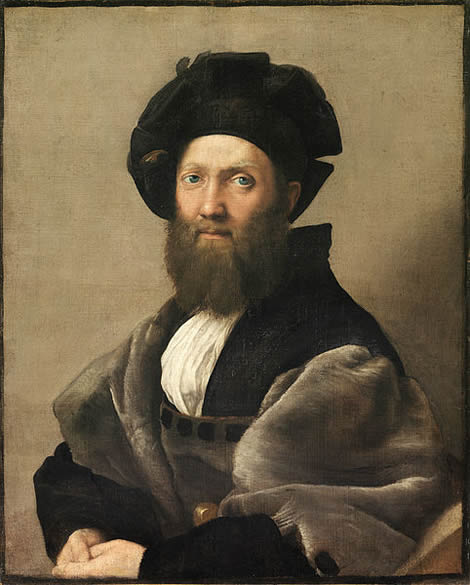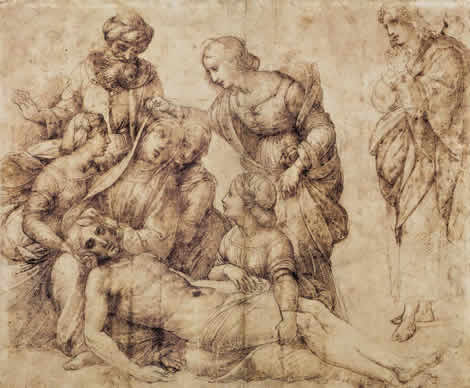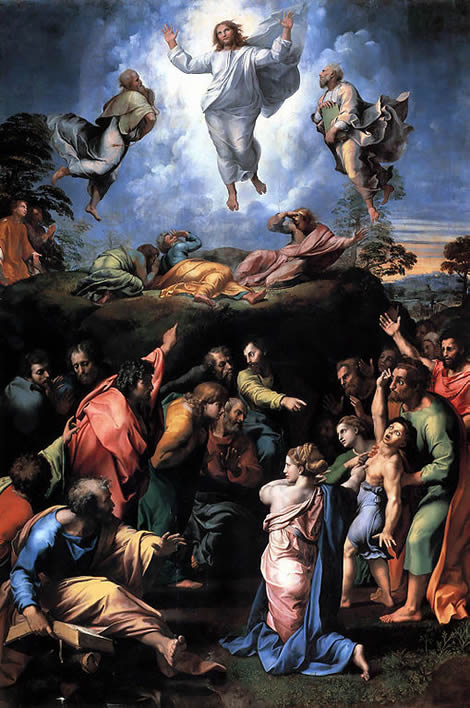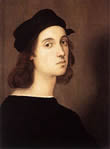Paintings

Portrait
of Baldassare Castiglione. 1514-5. Oil on Canvas. 82 cm. × 67 cm. Louvre, Paris.
The
portrait, one of the most celebrated in western painting, depicts Raphael's friend,
the diplomat and humanist Baldassare Castiglione, whose rapid ascent into courtly
circles paralleled that of Raphael himself. The piece was originally painted on wood
but later transferred to canvas. Seventeenth century copies show the hands in full,
suggesting several inches have been cut from the bottom.
The composition adopts
the common Renaissance pyramid, but there the conventional ceases. The piece is firstly
produced with the simplest of color schemes: warm grays and browns, with a touch of
blue for the eyes. The second feature to notice is the balance of shapes which the
composition creates: the figure occupies the frame so as to make the negative space
itself interesting, with the v-cuts in the outline of the hat repeated in the meeting
of the hat and collar, and the tilted wooden plane his let arm rests on. Those v-shapes
are also repeated in the folds of the squirrel fur trim and right elbow. A feather
in the hat balances the v-cut, makes a link to the beard and trim, and prevents the
hat appearing too heavy. Even the shapes of the black doublet and hat are constantly
varied, and form in themselves (half close your eyes to see) a descending scale that
is not allowed to become decorative but is tied to the background by dark shadows
in the extreme right of the painting. The sheen on the squirrel hair trim imparts
a glowing darkness to the doublet. The soft contours of the clothes, the fabrics involved
and the rounded beard suggest the subtlety of the man who wrote 'The Book of the
Courtier'. Many portrait painters copied these devices, most notably Ingres in
'Monsieur Bertin' and other portraits, but few created so sensitive a rendering.
Though the 'Book 'popularized the term'
sprezzatura', which has been translated as 'nonchalant
mastery', an effortless grace befitting a man of
culture, the portrayal is not of elegance but intelligence,
humility and honesty. The eyes are not identical,
and that on the sitter's right seems further back
(cover half the face with your hand). A unsettling
ambivalence is created, with one half of the personality
assertive and very much in control, and the other
half reserved, waiting and wary. The mouth is full
but cut off by the beard, where those dark bounding
cuts suggest a man who sees much he doesn't like
but will keep his own counsel.

Lamentation
1505-6 Pen and ink over stylus and black chalk, 33.4 cm. x 39.7 cm. Louvre, Paris
Most Renaissance painters made sketches, to try out compositional schemes and
make blueprints for assistants to enlarge and transfer in outline to walls and canvases.
Raphael's are particularly sensitive — more like the later Venetian painters
than his contemporaries in Rome — and helped shape the creative process. Over
400 survive, a small portion from an astonishingly prolific artist. First would come
rapid sketches, then more finished drawings and finally highly finished drawing for
transfer. Raphael learnt silverpoint while studying with Perugio, and he used this
extremely demanding medium that does not allow mistakes throughout his career. Pen
and ink was used extensively after 1505, and to these were often added washes in ink
or lead white. Black chalk drawings appear in his earliest drawings, and red chalk
— which allows delicate and extensive modulations of tone — after 1524.
Many of the drawings are of great beauty, and command enormous prices when they come
on the market.

Transfiguration.
1518-1520. Oil on Wood. 405 cm. × 278 cm. Pinacoteca Vaticana, Vatican City.
Cardinal Giulio de Medici, cousin to Pope Leo X, commissioned two paintings for the
cathedral of Narbonne, 'The Transfiguration of Christ 'from Raphael and 'The
Raising of Lazarus' from Sebastiano del Piombo, so rekindling the earlier competition
between Raphael and Michelangelo. Raphael worked feverishly to complete the work,
leaving assistants only to finished some of the lower left figures at his death in
1520. The difference in quality is very noticeable.
The painting combines two
biblical narratives: the transfiguration of Christ himself and the failure of the
Apostles fail to cure a boy from demons. Raphael made studies of all the figures and
incorporated them in a composition of intersecting triangles that is already looking
on to the future: to the Baroque in the dramatic lighting and vigorous gestures based
on diagonals, and to Mannerism in the dimensions and contorted poses of the figures.
The
picture seems to reference the delivery of the city of Narbonne from repeated assaults
of the Saracens, and a detailed iconography can be identified: even to the epilepsy
of the boy being evoked by the moon's reflection in the lower left of the painting.
The two figures kneeling on the left are Justus and Pastor, sharing the feast day
with the Feast of the Transfiguration and patrons of Medici's archbishopric and the
cathedral of Narbonne. The kneeling woman, painted in a lighter key and serving both
to link the two groups below and balance the ascending Christ above, adopts a figura
serpentinata or serpent's pose, with head and buttocks twisting in opposite directions
as she seems to turn away from the moonstruck boy and accept the attentions of the
nine apostles on the left. The figure on the far left may be Judas Escariot, and the
world below, darkly agitated with the sins of man, is contrasted with the ecstatic
purity and simplicity of the world above.
 Raffaello
Sanzio was born in Urbino on April 6, 1483. His father was a painter for the Duke
of Urbino, and taught his son the basics of the craft, so well that Raphael took over
the workshop at the age of eleven when his father died. His work soon attracted attention.
Perugino invited him over as an apprentice, and under the master's guidance the young
man developed the style seen in such works as the 'Mond Crucifixion' (c 1502),
the 'Three Graces' (c 1503), and the Oddi altarpiece, 'Marriage of the Virgin',
completed in 1504.
Raffaello
Sanzio was born in Urbino on April 6, 1483. His father was a painter for the Duke
of Urbino, and taught his son the basics of the craft, so well that Raphael took over
the workshop at the age of eleven when his father died. His work soon attracted attention.
Perugino invited him over as an apprentice, and under the master's guidance the young
man developed the style seen in such works as the 'Mond Crucifixion' (c 1502),
the 'Three Graces' (c 1503), and the Oddi altarpiece, 'Marriage of the Virgin',
completed in 1504. 

